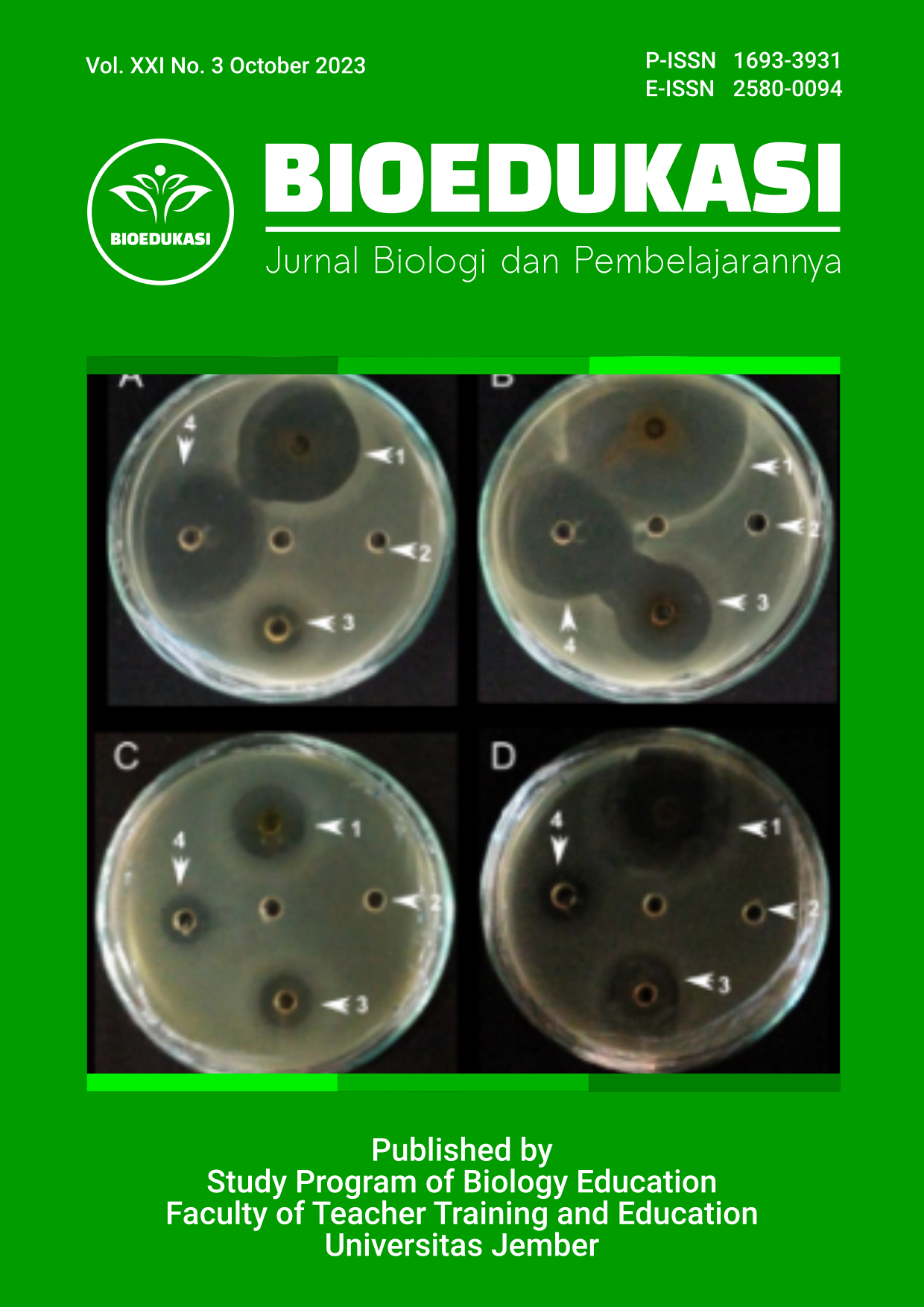Phenolic Profile and Antimicrobe of the Asplenium Nidus L. from Mount Gumitir, Jember, East Java, Indonesia
DOI:
https://doi.org/10.19184/bioedu.v21i3.43368Keywords:
Antimicrobe, Asplenium nidus, Flavonoid, Garahan; Gumitir, PhenolAbstract
Mount Gumitir, Jember, East Java has a high number of wild flora for new medicinal resources. Asplenium nidus is a medicinal ferns that abundant in the area. This research aimed to measure the phenolic compound of the lamina and midrib sample of A. nidus from two different locations and the antimicrobial activity of the crude extract of fresh and dry sample. The phenolic compounds of flavonoid and phenol were detected using quercetin and Folin-Ciocalteu reagent respectively. The quantitative analysis of phenolic compounds was conducted based on absorbance detection using a spectrophotometer. The antimicrobial assay was applied with the agar diffusion method against the gram-positive bacterium Staphylococcus aureus and gram-negative bacteria Escherichia coli. The result indicated that all samples of A. nidus contained flavonoid and phenol with a higher concentration in the lamina. The crude extract of A. nidus from Gumitir has higher phenolic compounds compared to the sample from Garahan. The crude extract presented bactericide activity against the two pathogenic bacteria. The higher antimicrobial activity was observed from the dry leaves sample. The phenolic compound of A. nidus might become a potential resource for the treatment of multidrug-resistant bacteria since their bactericide activities differ from traditional antibiotics.
Downloads
References
Cahyaningsih, R., Magos Brehm, J., & Maxted, N. 2021. Gap analysis of Indonesian priority medicinal plant species as part of their conservation planning. Global Ecology and Conservation, 26, e01459. https://doi.org/10.1016/J.GECCO.2021.E01459
Hammami, S., Snène, A., El Mokni, R., Faidi, K., Falconieri, D., Dhaouadi, H., Piras, A., Mighri, Z. and Porcedda, S., 2016. Essential oil constituents and antioxidant activity of Asplenium ferns. Journal of chromatographic science, 54(8), pp.1341-1345.
Jarial, R., Thakur, S., Sakinah, M., Zularisam, A.W., Sharad, A., Kanwar, S.S. and Singh, L., 2018. Potent anticancer, antioxidant and antibacterial activities of isolated flavonoids from Asplenium nidus. Journal of King Saud University-Science, 30(2), pp.185-192.
Klatt, S., Hadacek, F., HodaÄ, L., Brinkmann, G., Eilerts, M., Hojsgaard, D. and Hörandl, E., 2016. Photoperiod extension enhances sexual megaspore formation and triggers metabolic reprogramming in facultative apomictic Ranunculus auricomus. Frontiers in Plant Science, 7, p.278.
Kim S, Lee S, Lee H, Ha J, Lee J, Choi Y, Oh H, Hong J, Yoon Y, Choi KH. 2017. Evaluation on Antimicrobial Activity of Psoraleae semen Extract Controlling the Growth of Gram-Positive Bacteria. Korean J Food Sci Anim Resour.;37(4):502-510. Doi: 10.5851/kosfa.2017.37.4.502.
Lim, X. Y., I, B. P., & Tan, T. Y. C. 2021. Medicinal Plants in COVID-19: Potential and Limitations. Frontiers in Pharmacology, 12, 355. https://doi.org/10.3389/FPHAR.2021.611408/BIBTEX
Mukherjee, P. K., Efferth, T., Das, B., Kar, A., Ghosh, S., Singha, S., Debnath, P., Sharma, N., Bhardwaj, P. K., & Haldar, P. K. 2022. Role of medicinal plants in inhibiting SARS-CoV-2 and in the management of post-COVID-19 complications. Phytomedicine, 98. https://doi.org/10.1016/J.PHYMED.2022.153930
Ratnasari, T., Sulistiyowati, H. and Setyati, D. 2022. Identifikasi Bioprospeksi Senyawa Aktif Terkandung dalam Bahan Baku Sirup Herbal Kube Minuman Herbal Resort Wonosari Taman Nasional Meru Betiri. In Agropross: National Conference Proceedings of Agriculture (pp. 517-523).
Sampaio, B., Edrada-Ebel, R. & Da Costa, F. 2016. Effect of the environment on the secondary metabolic profile of Tithonia diversifolia: a model for environmental metabolomics of plants. Sci Rep 6, 2926). https://doi.org/10.1038/srep29265
Setyati, D., Sulistiyowati, H., Erizcy, M.P. and Ratnasari, T. 2020. The Flavonoid and alkaloid content of Cyclosorus parasiticus (Linn.) farwell ferns at the plantation areas of Jember Regency. BIOLINK (Jurnal Biologi Lingkungan Industri Kesehatan), 7(1), pp.23-37.
Setyati, D., Sulistyowati, H., Rahmawati, R. and Ratnasari, T. 2021, May. The spores structure of ferns growing in mountain Gumitir coffee plantation area Jember Regency. In IOP Conference Series: Earth and Environmental Science (Vol. 743, No. 1, p. 012089). IOP Publishing.
Tahir, M.M., Wai, Y.C., Yaacob, W.A. and Ibrahim, N. 2015. Antibacterial, cytotoxicity and antiviral activities of Asplenium nidus. Journal of Chemical and Pharmaceutical Research, 7(7), pp.440-444.
Takó, M., Kerekes, E.B., Zambrano, C., Kotogán, A., Papp, T., Krisch, J. and Vágvölgyi, C., 2020. Plant phenolics and phenolic-enriched extracts as antimicrobial agents against food-contaminating microorganisms. Antioxidants, 9(2), p.165.
Uddin, T.M., Chakraborty, A.J., Khusro, A., Zidan, B.R.M., Mitra, S., Emran, T.B., Dhama, K., Ripon, M.K.H., Gajdács, M., Sahibzada, M.U.K. and Hossain, M.J., 2021. Antibiotic resistance in microbes: History, mechanisms, therapeutic strategies and future prospects. Journal of infection and public health, 14(12), pp.1750-1766.
Ulum, F.B. and Setyati, D., 2015. Ephypitic Ferns (Pteridophyta) from Raung Mount Banyuwangi, East Java Indonesia. Jurnal ILMU DASAR, 16(1), pp.7-12.
Ulum, F.B. and Setyati, D., 2017. Pteridophytes of Alas Purwo National Park and Their Medicinal Potency. UNEJ e-Proceeding, pp.80-82.
Ulum, F.B., Hadacek, F. and Hörandl, E., 2021. Polyploidy improves photosynthesis regulation within the Ranunculus auricomus complex (Ranunculaceae). Biology, 10(8), p.811.
Ulum, F.B., Setyati, D. and Su'udi, M., 2023. Epiphytic ferns and orchids adaptation mechanism based on stomatal structure and chlorophyll content in Urban Forest of Jember University, Indonesia. Life Science and Biotechnology, 1(1), pp.10-15.
Zhang, Y., Cai, P., Cheng, G. and Zhang, Y., 2022. A brief review of phenolic compounds identified from plants: Their extraction, analysis, and biological activity. Natural Product Communications, 17(1), p.1934578X211069721.
Velu, G., Palanichamy, V., & Rajan, A. P. 2018. Phytochemical and Pharmacological Importance of Plant Secondary Metabolites in Modern Medicine. Bioorganic Phase in Natural Food: An Overview, 135–156. https://doi.org/10.1007/978-3-319-74210-6_8
Živković, S., Milutinović, M., Maksimović, V., Ćirić, A., Ivanov, M., Božunović, J., Banjanac, T. and Mišić, D., 2020. Antioxidant and antimicrobial activity of two Asplenium species. South African Journal of Botany, 132, pp.180-187.




 https://orcid.org/0000-0003-1920-0515
https://orcid.org/0000-0003-1920-0515